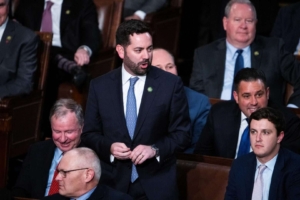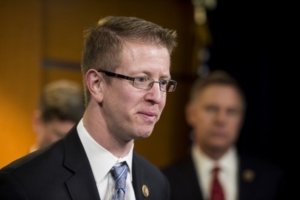
A Subcommittee and a Letter Writer Offer Ways to Move Past Dysfunction
A congressional subcommittee and a letter-writer from New York share something in common – they both have intriguing ideas intended to make Congress work better.
The ideas include scheduling committee hearings so congressmen don’t have to be in two places at the same time; creating space where staff members of both parties can relax and talk; and empowering moderate Republicans to move past House legislative dysfunction.
Scheduling efficiency and collaborative space are nice. Finding a way out of political paralysis in the House is essential. Almost 40 sitting House members in both parties, three from the Pacific Northwest, have already decided not to seek re-election. Frustration with a dysfunctional Congress is a contributing factor.
Small changes can produce big results.
Dealing with Dysfunction
 John Stockton, an attorney in Harrison, New York, offered a simple solution to House stalemate in a 200-word letter to the editor in The New York Times. His idea: The dozen or so Republicans representing Democratically leaning congressional districts could declare themselves independents, force the election of a moderate House Speaker and isolate naysayers on the far right to move overdue legislation.
John Stockton, an attorney in Harrison, New York, offered a simple solution to House stalemate in a 200-word letter to the editor in The New York Times. His idea: The dozen or so Republicans representing Democratically leaning congressional districts could declare themselves independents, force the election of a moderate House Speaker and isolate naysayers on the far right to move overdue legislation.
This step would mimic what far right members have been doing – using their leverage in a narrowly divided House with a razor-thin GOP majority to gum up the legislative process. If moderates flexed their political muscle, Harrison thinks they could un-gum the process.
“They would be in the same position of control as the far right caucus,” he wrote. “But their control would be over the entire body as opposed to their own party. With that control, they could cause compromise bills to go forward and Congress would work again.”
 The simplicity of Stockton’s suggestion discounts the political tribulation Republicans-turned-independents would face when they ran for re-election. Without saying as much in his letter, Stockton implied they may increase their chances for re-election based on getting the House back on track to approve appropriations and a national security package.
The simplicity of Stockton’s suggestion discounts the political tribulation Republicans-turned-independents would face when they ran for re-election. Without saying as much in his letter, Stockton implied they may increase their chances for re-election based on getting the House back on track to approve appropriations and a national security package.
At the moment, both are stalled. Far-right House Republicans insist on putting policy riders on appropriations, which is a non-starter in the Senate. The same conservative members have their thumb on a national security package, demanding more border restrictions than were negotiated in a bipartisan Senate compromise or included in a Problem-Solvers Caucus proposal.
Ulterior Motives
A skeptic may conclude that the Freedom Caucus strategy is to keep spending bottled up into September when a deal cut by former Speaker Kevin McCarthy included a provision that requires massive spending cuts if Congress fails to pass appropriations. The prospect seemed very unlikely months ago, but not so far-fetched now.
Congress may be forced by sheer timing to approve another stopgap spending bill before the next deadline for a partial government shutdown occurs March 1. The partial shutdown could enlarge without a resolution on spending before March 8. The House isn’t scheduled to reconvene until Wednesday – two days before the first deadline.
Stockton’s suggestion may be more realistic than even he imagined when he submitted his letter to The Times. Two discharge petitions have been filed to bring a national security package directly to the House floor. They would require only a handful of Republicans to join with most Democrats in passing either one of them. That would be a makeshift way to accomplish what Stockton urged.
 Modernizing Congress
Modernizing Congress
As Washington Congressman Derek Kilmer moves toward retiring, the challenge of modernizing Congress has fallen to second-term Oklahoma Republican Congresswoman Stephanie Bice. The Select Committee on the Modernization of Congress, which Kilmer chaired, was scrapped and replaced with the House Administration Modernization Subcommittee, which Bice chairs.
In the spirit of Kilmer’s innovations – his committee met in a circle, Bice has reclaimed an empty space on the fourth floor of the Cannon House Office Building, installed comfortable chairs and encourage Hill staffers to relax and talk to their peers, including ones representing House members from an opposing party.

“We kept hearing over and over there was a need for an area where staff can grab a Coke and just sit down and chat,” Bice said, as she tried out a chair under a mural that describes the area as “Staff Collaboration Space”.
Small Changes and Big Results
Small changes can produce big results, Bice said. It’s a lesson learned from Kilmer, who squeezed 200 small changes in congressional procedures during his four-year stint as head of the Modernization Committee.
“The desire was not to just make recommendations. It was to make change within the institution,” Kilmer said. “Part of the value of the subcommittee has been continuing to press forward on implementation.” Creation of the permanent subcommittee was Recommendation 130 of the 200 small changes Kilmer’s leadership produced.
Under Bice’s leadership, the subcommittee took a deep dive into the Congressional Research Service that provides research for Members of Congress. Bice probed why CRS had high turnover, low morale and was slow to adopt new technology.
The subcommittee’s more typical targets is making it easier for congressional offices to request flags flown over the Capitol for constituents and unraveling scheduling conflicts that detract from congressional committee participation an contribute to member burnout.
 The subcommittee recommended an app called Deconflict, which has been in use since last spring by the House Digital Service. Bice touted a pilot program of a digital tool known as FlagTrack to ease flag request paperwork. A future project Bice has identified if improving accessibility for staff members and visitors with disabilities.
The subcommittee recommended an app called Deconflict, which has been in use since last spring by the House Digital Service. Bice touted a pilot program of a digital tool known as FlagTrack to ease flag request paperwork. A future project Bice has identified if improving accessibility for staff members and visitors with disabilities.
Funding for projects comes from the Modernization Initiatives Account, which received $10 million in fiscal 2023, up from $2 million. “It’s a small amount of money, so we have to be very diligent and make sure that we’re using it wisely and choosing projects that get the most bang for our buck,” Bice said.
Challenge of Changing Congress
Making changes in Congress is its own challenge. The Staff Collaboration Space was included as a recommendation in a report accompanying the fiscal 2023 Legislative Branch appropriations, which directed the Architect of the Capitol to identify places in House office buildings that could feasibly be transformed. The space was just established.
 “Our capacity to move forward is stymied by legislative dysfunction,” Kilmer admits. “But I think what’s been refreshing about this work is it’s not partisan. Congresswoman Bice has come to this with an eye toward strengthening the institution, not toward driving a partisan agenda.”
“Our capacity to move forward is stymied by legislative dysfunction,” Kilmer admits. “But I think what’s been refreshing about this work is it’s not partisan. Congresswoman Bice has come to this with an eye toward strengthening the institution, not toward driving a partisan agenda.”
Last year, Kilmer joined with another select committee veteran, South Carolina Republican Congressman William R. Timmons IV, to form the Fix Congress Caucus as a way for more lawmakers to pursue modernization of an institution that often shows its age and defects.




